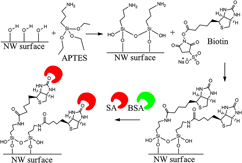Crossref Citations
This article has been cited by the following publications. This list is generated based on data provided by
Crossref.
Oleshko, V P
Williams, E H
Davydov, A V
Krylyuk, S
Motayed, A
Ruzmetov, D
Lam, T
Lezec, H J
and
Talin, A A
2013.
Analytical Electron Microscopy of Semiconductor Nanowire Functional Materials and Devices for Energy Applications.
Journal of Physics: Conference Series,
Vol. 471,
Issue. ,
p.
012017.
Williams, Elissa H.
Davydov, Albert V.
Oleshko, Vladimir P.
Steffens, Kristen L.
Levin, Igor
Lin, Nancy J.
Bertness, Kris A.
Manocchi, Amy K.
Schreifels, John A.
and
Rao, Mulpuri V.
2014.
Solution-based functionalization of gallium nitride nanowires for protein sensor development.
Surface Science,
Vol. 627,
Issue. ,
p.
23.
Haughey, Anne-Marie
Guilhabert, Benoit
L Kanibolotsky, Alexander
J Skabara, Peter
D Dawson, Martin
A Burley, Glenn
and
Laurand, Nicolas
2014.
An oligofluorene truxene based distributed feedback laser for biosensing applications.
Biosensors and Bioelectronics,
Vol. 54,
Issue. ,
p.
679.
Prakash, Jyoti
Venugopalan, Ramani
Tripathi, B.M.
Ghosh, S.K.
Chakravartty, J.K.
and
Tyagi, A.K.
2015.
Chemistry of one dimensional silicon carbide materials: Principle, production, application and future prospects.
Progress in Solid State Chemistry,
Vol. 43,
Issue. 3,
p.
98.
Wu, Renbing
Zhou, Kun
Yue, Chee Yoon
Wei, Jun
and
Pan, Yi
2015.
Recent progress in synthesis, properties and potential applications of SiC nanomaterials.
Progress in Materials Science,
Vol. 72,
Issue. ,
p.
1.
Bano, Edwige
Fradetal, Louis
Ollivier, Maelig
Choi, Ji-Hoon
and
Stambouli, Valérie
2016.
Silicon Carbide Biotechnology.
p.
261.
Fradetal, L
Bano, E
Attolini, G
Rossi, F
and
Stambouli, V
2016.
A silicon carbide nanowire field effect transistor for DNA detection.
Nanotechnology,
Vol. 27,
Issue. 23,
p.
235501.
Saddow, Stephen E.
2016.
Silicon Carbide Biotechnology.
p.
1.
Vranceanu, D.M.
Cotrut, C.M.
Bramowicz, M.
Titorencu, I.
Kulesza, S.
Kiss, A.
Berbecaru, A.
Pruna, V.
Branzei, M.
and
Vladescu, A.
2016.
Osseointegration of sputtered SiC-added hydroxyapatite for orthopaedic applications.
Ceramics International,
Vol. 42,
Issue. 8,
p.
10085.
Ponraj, Joice Sophia
Dhanabalan, Sathish Chander
Attolini, Giovanni
and
Salviati, Giancarlo
2016.
SiC Nanostructures Toward Biomedical Applications and Its Future Challenges.
Critical Reviews in Solid State and Materials Sciences,
Vol. 41,
Issue. 5,
p.
430.
Constantinou, Marios
Hoettges, Kai F.
Krylyuk, Sergiy
Katz, Michael B.
Davydov, Albert
Rigas, Grigorios-Panagiotis
Stolojan, Vlad
Hughes, Michael P.
and
Shkunov, Maxim
2017.
Rapid determination of nanowires electrical properties using a dielectrophoresis-well based system.
Applied Physics Letters,
Vol. 110,
Issue. 13,
Kalyuzhnaya, Anna
Efimova, Aleksandra
Golovan, Leonid
Gonchar, Kirill
and
Timoshenko, Victor
2017.
Silicon Nanomaterials Sourcebook.
p.
3.
Jobdeedamrong, Arjaree
Jenjob, Ratchapol
and
Crespy, Daniel
2018.
Encapsulation and Release of Essential Oils in Functional Silica Nanocontainers.
Langmuir,
Vol. 34,
Issue. 44,
p.
13235.
Han, Chang-Ho
Woo, Seong Yong
Bhardwaj, Jyoti
Sharma, Abhinav
and
Jang, Jaesung
2018.
Rapid and selective concentration of bacteria, viruses, and proteins using alternating current signal superimposition on two coplanar electrodes.
Scientific Reports,
Vol. 8,
Issue. 1,
Garcia-Cruz, Alvaro
Lee, Michael
Zine, Nadia
Sigaud, Monique
Marote, Pedro
Lopez, Manuel
Bausells, Joan
Jaffrezic-Renault, Nicole
and
Errachid, Abdelhamid
2018.
Biopatterning of antibodies on poly(pyrrole)-nanowires using nanocontact printing: Surface characterization.
Materials Science and Engineering: C,
Vol. 91,
Issue. ,
p.
466.
Gil, J.C
Ferreira, L.F.
Silva, V.C.
Oliveira, A.C.
de Oliveira, R.R.
and
Jacinto, M.J.
2019.
Facile fabrication of functionalized core-shell Fe3O4@SiO2@Pd microspheres by urea-assisted hydrothermal route and their application in the reduction of nitro compounds.
Environmental Nanotechnology, Monitoring & Management,
Vol. 11,
Issue. ,
p.
100220.
Martínez-Domingo, Carme
Conti, Silvia
de la Escosura-Muñiz, Alfredo
Terés, Lluís
Merkoçi, Arben
and
Ramon, Eloi
2020.
Organic-based field effect transistors for protein detection fabricated by inkjet-printing.
Organic Electronics,
Vol. 84,
Issue. ,
p.
105794.
Cooper, Oren
Phan, Hoang-Phuong
Wang, Bei
Lowe, Sean
Day, Christopher J.
Nguyen, Nam-Trung
and
Tiralongo, Joe
2020.
Functional Microarray Platform with Self-Assembled Monolayers on 3C-Silicon Carbide.
Langmuir,
Vol. 36,
Issue. 44,
p.
13181.
dos Santos, Renata Patrícia
Araujo Lopes, Cristina Moniz
Baldan, Mauricio Ribeiro
and
Cassu, Silvana Navarro
2020.
On the preparation of organosilanized silicon carbide aqueous suspension.
Ceramics International,
Vol. 46,
Issue. 2,
p.
1793.
Berktas, Ilayda
Ghafar, Ali Nejad
Fontana, Patrick
Caputcu, Ayten
Menceloglu, Yusuf
and
Okan, Burcu Saner
2020.
Facile Synthesis of Graphene from Waste Tire/Silica Hybrid Additives and Optimization Study for the Fabrication of Thermally Enhanced Cement Grouts.
Molecules,
Vol. 25,
Issue. 4,
p.
886.



